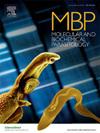Identification and initial characterisation of Trypanosoma Cox17 copper metallochaperone
IF 1.4
4区 医学
Q4 BIOCHEMISTRY & MOLECULAR BIOLOGY
引用次数: 0
Abstract
Copper plays an essential role in organisms as a catalytic co-factor for key enzymes like cytochrome c oxidase. Copper importation, distribution and secretion is carried out by copper transport and copper-binding proteins known as copper chaperones. Cox17 is a chaperone that conveys copper to Cox11 and Sco1 for metalation of the CuB and CuA of Cox1 and Cox2 respectively in eukaryotes. Cox17 from Trypanosoma brucei brucei and T. congolense were recombinantly expressed and affinity purified as MBP-fusion proteins. An ascorbic acid oxidation assay, a BCA-release assay and an in vivo growth inhibition assay confirmed the presence of copper bound to the proteins. Trypanosomal Cox17 and other copper-binding proteins are expressed at higher levels in the insect procyclic stage where cytochrome c oxidase is active, compared to the bovine bloodstream forms. In silico docking models suggests possible interaction partners for Cox17.
锥虫Cox17铜金属伴侣蛋白的鉴定与初步表征。
铜作为细胞色素c氧化酶等关键酶的催化辅助因子在生物体中起着至关重要的作用。铜的输入、分布和分泌是通过铜转运和铜结合蛋白(即铜伴侣蛋白)进行的。Cox17是一种伴侣蛋白,它将铜传递给Cox11和Sco1,分别用于真核生物Cox1和Cox2的CuB和CuA的金属化。重组表达了来自布氏锥虫和刚果锥虫的Cox17,并将其纯化为mbp融合蛋白。抗坏血酸氧化试验、bca释放试验和体内生长抑制试验证实了铜与蛋白质结合的存在。与牛的血流形式相比,在细胞色素c氧化酶活跃的昆虫前环阶段,锥虫体Cox17和其他铜结合蛋白的表达水平更高。计算机对接模型显示了Cox17可能的相互作用伙伴。
本文章由计算机程序翻译,如有差异,请以英文原文为准。
求助全文
约1分钟内获得全文
求助全文
来源期刊
CiteScore
2.90
自引率
0.00%
发文量
51
审稿时长
63 days
期刊介绍:
The journal provides a medium for rapid publication of investigations of the molecular biology and biochemistry of parasitic protozoa and helminths and their interactions with both the definitive and intermediate host. The main subject areas covered are:
• the structure, biosynthesis, degradation, properties and function of DNA, RNA, proteins, lipids, carbohydrates and small molecular-weight substances
• intermediary metabolism and bioenergetics
• drug target characterization and the mode of action of antiparasitic drugs
• molecular and biochemical aspects of membrane structure and function
• host-parasite relationships that focus on the parasite, particularly as related to specific parasite molecules.
• analysis of genes and genome structure, function and expression
• analysis of variation in parasite populations relevant to genetic exchange, pathogenesis, drug and vaccine target characterization, and drug resistance.
• parasite protein trafficking, organelle biogenesis, and cellular structure especially with reference to the roles of specific molecules
• parasite programmed cell death, development, and cell division at the molecular level.

 求助内容:
求助内容: 应助结果提醒方式:
应助结果提醒方式:


